 Another ‘Top 10″ attraction of PR and San Juan in particular.
Another ‘Top 10″ attraction of PR and San Juan in particular.
Yes, the gardens on the grounds of the University of Puerto Rico (UPR) had been on my original ‘hit-list’ of places to see. I’m a little ashamed I had not come to visit before now. The SJ Photo MeetUp Group decided to come back and check it out so that was all the 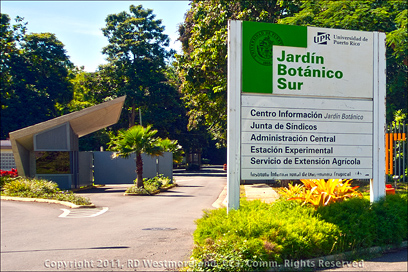 excuse I needed.
excuse I needed.
Though some tropical plants flower year round, this is the tail end of the summertime flower explosion. There is something in bloom year round, but it was evident that many things had gone to seed or past that. The dry season starts in late December so most things go into a dormant state.
The weather was sunny, balmy and in the the mid-80’s F.
I would normally wear shorts, but I often need to kneel for shots so jeans are a minimum. A hat is a good idea too as well as an umbrella for afternoon showers.
The UPR Botanical Gardens are located on Highway 1 between the Highway 21 exchange and the Highway 3 exchange. There is actually 2 parts to the garden, bisected by Highway 1. There was enough signage to find it without backtracking. The garden area for visitors is designated Botanical Garden South.  The entrance to the South Garden is pretty boldly marked, once you make the turn off Highway 1. You can’t miss it.
The entrance to the South Garden is pretty boldly marked, once you make the turn off Highway 1. You can’t miss it.
In 1910, the Botanical Garden grounds were originally dedicated to the development of better varieties of sugarcane by the Association of Sugar Producers. Back then it was called the Agricultural Experimental Station. There are several structures on the grounds that hark back to this period. The Tropical Agricultural Research Station of Mayagüez still conducts some research here, though it has nothing to do with sugarcane. The greenhouses belong to them.
In 1989, Hurricane Hugo trashed the park (as was the rest of PR). Restoration took 2 years before it opened again to the public.
The UPR Botanical Gardens are free as is parking!
The UPR grounds are open to the public 7 days a week from 6AM to 6PM. It is closed for a few holidays each year. Guided tours for 10 or more can be arranged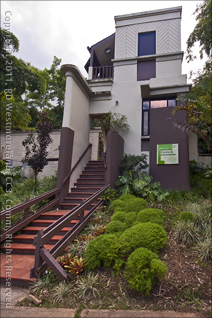 by calling 787-758-9957.
by calling 787-758-9957.
There’s even a cute, bright green trolley to ride in. Costs, if any were not stated. The public space can accommodate concerts, 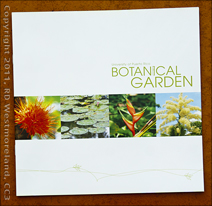 weddings and large picnics which can be arranged through the main office. We ‘met-up’ in the first parking lot after the security sign-in shack.
weddings and large picnics which can be arranged through the main office. We ‘met-up’ in the first parking lot after the security sign-in shack.
That is where you will find the visitors center.
From there you may score a small booklet about the UPR Botanical Gardens available in Spanish or English. I have to pause and complement U of PR on this very well done piece of commercial printing. It is obvious, a lot of time and effort went into it’s content, design and printing.
Everything you need to know about the Gardens is covered.
It was the nicest handout I have seen since I have been touring the island. I wish more locations provided material like this. It is something folks will take home and rave about to friends. 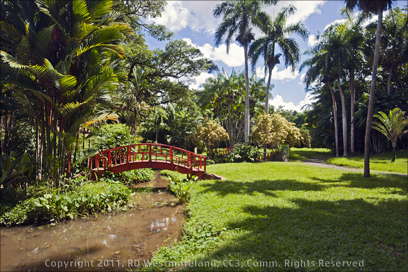 A quality product that delivers the goods in a tasteful, unobtrusive way. Much of the material presented here, was taken from it.
A quality product that delivers the goods in a tasteful, unobtrusive way. Much of the material presented here, was taken from it.
OK.. ’nuff said.
UPR has a Spanish language Website with a page dedicated to the Botanical Park. There is a list of phone numbers at the bottom of the page, if you need to contact them directly.
There are no less than 8 designated garden areas in the Southern Garden covering 75 acres open to the public. There were several well maintained restrooms spread across the grounds as well as places to sit.
Some of it would not be considered handicap capable, but then little has changed since it opened in 1971.
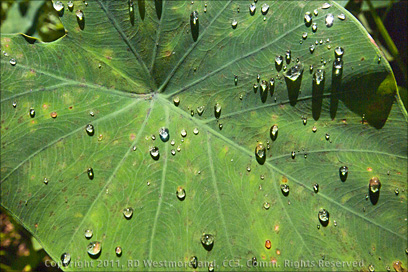
This garden is several times larger than the one in Caguas, but it did not start out as dedicated public space like the one in Caguas. Plus the Botanical Gardens in Caguas are relatively new in comparison. Both have their points of interest. I tend to think of the Caguas Gardens as a ‘compact version’ of the one in San Juan. More to see with less walking.
We covered about half of the Botanical Garden by taking the ‘La Arbolada Excursion Path’ to the right of the small creek. It cuts pretty much down the middle of the park. The path is an easy walk, but I would not consider it wheelchair passable as it is covered in loose gravel.
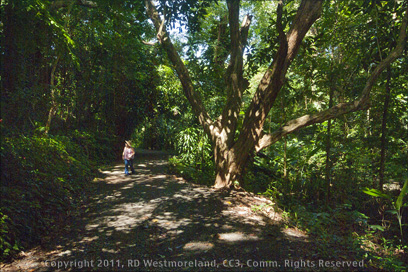 This path took us past the Aquatic Garden, the Bamboo Chapel and the Monet Garden. We continued along the path out to a small lake next to the Bromeliad Garden. I stopped at the Medicinal Plant area at the very back, but it was closed to the public. That was followed by the Sculpture Garden, the Fountains with giant Palms, then onto a second lake that’s not on the brochure map. On our way back via the Flor de Maga street, we passed the greenhouses and Ficus benjamina area before pausing for the usual MeetUp group shot.
This path took us past the Aquatic Garden, the Bamboo Chapel and the Monet Garden. We continued along the path out to a small lake next to the Bromeliad Garden. I stopped at the Medicinal Plant area at the very back, but it was closed to the public. That was followed by the Sculpture Garden, the Fountains with giant Palms, then onto a second lake that’s not on the brochure map. On our way back via the Flor de Maga street, we passed the greenhouses and Ficus benjamina area before pausing for the usual MeetUp group shot.
It was a long jag, but there were plenty of places to pause and rest. Total time was about 2 and a half hours.
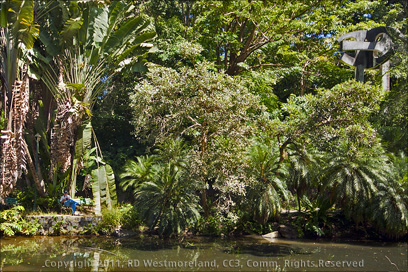 Because of how much ground I covered it felt more like a quick run-through. We will be back to take our time and check out what we missed.
Because of how much ground I covered it felt more like a quick run-through. We will be back to take our time and check out what we missed.
The cute red wooden bridges of the Aquatic Garden were well worn and missing a few steps. They had nailed boards across the rails to prevent entrance, but that did not deter the local kids from playing on them. The park may be old, but well maintained.
My favorite places were the Monet Garden, the Fountain area and the little lake at the very back of the grounds.
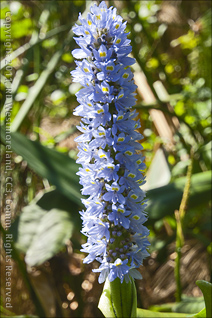 There are several dedicated sitting areas surrounding the small lake at the Monet Garden. Lots of turtles swimming within the lilypads and flowers growing out of the lake. An area worth more exploration.
There are several dedicated sitting areas surrounding the small lake at the Monet Garden. Lots of turtles swimming within the lilypads and flowers growing out of the lake. An area worth more exploration.
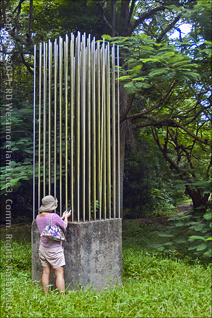 The Fountain area was an open space with several smaller stone paths through it. Mixed in with the fountains were some beautiful palms.. the largest I’ve ever seen. Taller than the ones at the Mayaguez Tropical Agriculture Research Center. This area is immaculately maintained.
The Fountain area was an open space with several smaller stone paths through it. Mixed in with the fountains were some beautiful palms.. the largest I’ve ever seen. Taller than the ones at the Mayaguez Tropical Agriculture Research Center. This area is immaculately maintained.
Off the edge of this, to the high side was a small lake. It also had nice water features and a place to sit and rest.
 A very large Carambola (Star Fruit) tree marked the space between the lake and the Fountain area. There were many ripe fruit so I sampled a couple, but they were very tart and definitely not sweet. Not all Carambola are sweet. Taste can vary from plant to plant.. even seeds grown from the same fruit.
A very large Carambola (Star Fruit) tree marked the space between the lake and the Fountain area. There were many ripe fruit so I sampled a couple, but they were very tart and definitely not sweet. Not all Carambola are sweet. Taste can vary from plant to plant.. even seeds grown from the same fruit.
 The Sculpture Garden was also interesting. These were more freeform, abstract works of art. I liked them. I will be back to shoot them in better light.
The Sculpture Garden was also interesting. These were more freeform, abstract works of art. I liked them. I will be back to shoot them in better light.
Flor de Maga street runs the full length of the parks so we walked it back to the parking lot.
We passed the Mayagüez TropAg Greenhouses along way. The MeetUp group paused for it’s usual group shot in front of a beautiful stand of Bamboo culms. After that, we said our goodbyes.
The sky had turned dark by the time we hit the parking lot.
We got hit by a wall of rain as we drove past Caguas and Cayey towards home. 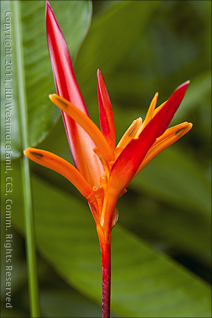 As usual though, once we dropped down out of the mountains to the South shore, the rain broke. I don’t think it had even rained on our side of the island.
As usual though, once we dropped down out of the mountains to the South shore, the rain broke. I don’t think it had even rained on our side of the island.
The University of Puerto Rico Botanical Gardens (sometimes referred to as the San Juan Botanical Gardens) is a must see. 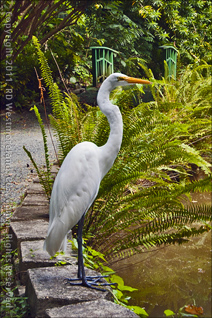 If you’ve already walked the streets of Old San Juan, checked out El Morro and the local museums, then you might want to come visit the Gardens.
If you’ve already walked the streets of Old San Juan, checked out El Morro and the local museums, then you might want to come visit the Gardens.
And don’t forget to score a brochure before you start your walk.
I promise you, every cabbie in San Juan, knows where the the Botanical Gardens are. Just make sure you settle on a fee up front..
they don’t always drop a flag.
BTW- If you do a search on GoogleMaps (as of this post), it takes you to a park in Old San Juan. That would be wrong. The UPR Botanical Gardens are located in Rio Piedras.
That’s about dead center of the Greater San Juan metroplex.
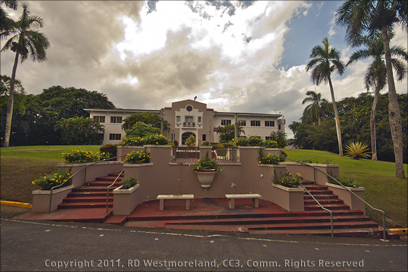

bill grappone says
interested in learning more local lepidoptera in puerto rico. (s.dog- working on a new post regarding just that subject.)